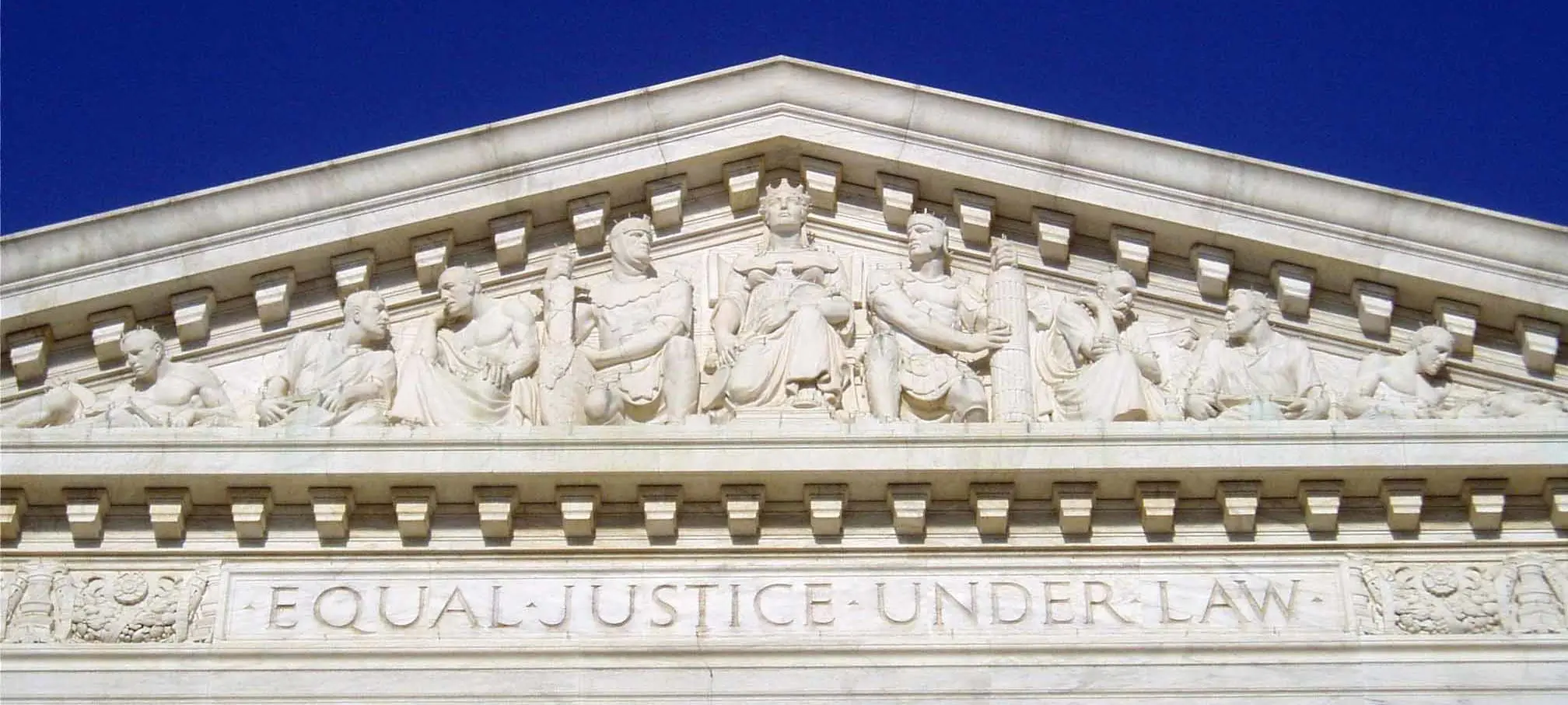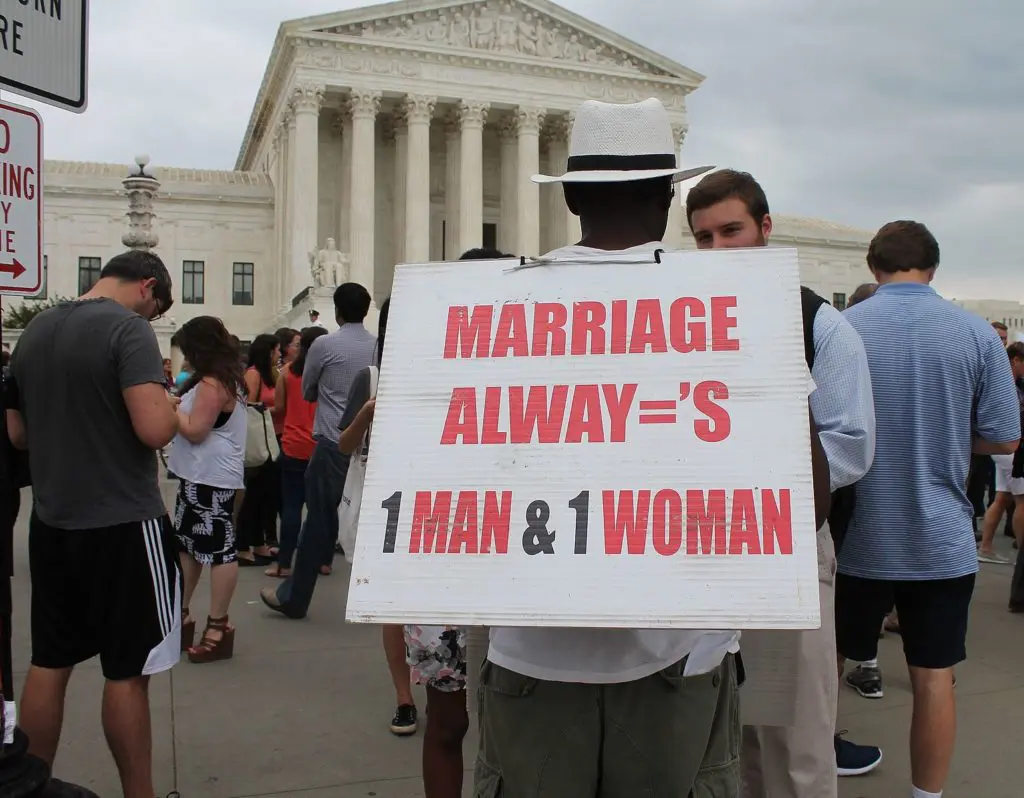The legalization of same-sex marriage by the Supreme Court of the United States is an undeniable tragedy of the modern political and legal culture of death. How and why this decision came to be the unappealable law of the land is a very long story.
Here are some of the more important issues at stake in this story which you need to be aware of in order to understand what happened in October of 2014 in the case of Obergefell v. Hodges.

Courtesy: Photographer Matt Wade, shot CC BY-SA 3.0 at Wikipedia
What Was the Goal of the Petitioners?
The petitioners to the Supreme Court in this case were fourteen same-sex couples who sought to have their marital status recognized in every state and two men whose same-sex partners had died and wished to have the legal privileges of those whose opposite-sex spouses pass away.
Some of these couples had been given official marriage licenses in states that allowed same-sex “marriage,” but they were not recognized by states such as Michigan, Kentucky, Ohio, and Tennessee. These states adhered to the true definition of marriage as a union of one man and one woman. The goal of these petitioners was legal recognition of their “marriage” in all fifty states.
It is undeniable that the status of being legally married does come with its legal privileges. The petitioners wished to share these benefits despite their union being incongruous with the true Christian meaning of marriage. The official case syllabus, petitioners make it a prominent point that “far from seeking to devalue marriage, [they] seek it for themselves because of their respect—and need—for its privileges and responsibilities.”
Regardless of whether that was the true goal of these petitioners, this case established the status of same-sex couples beyond the scope of state law and made them legally equal under federal law to traditional heterosexual married couples.
Demonizing Christianity Begins
In the years since, this movement has picked up the pace and become more overtly hostile to dissenters. While the Court granted them the rights for which they petitioned, the rainbow movement cites this decision as justification for attacking all those who will not acquiesce to their demands. Though they allege they advocate toleration for all, those advocating gay marriage ideology often have a singular intolerance for the traditional family values and its proponents. Why?
Acting out on same-sex inclinations is a sexual disorder. To know that in the eyes of Christianity their acts are perversions of healthy, normal sexuality is a position these folks cannot abide.
One does not have to look very far to find current examples of this intolerance in our country. (At the time of writing this, I only had to open my web browser and without even searching was greeted front and center by this headline.) “Colorado Christian cakeshop sued a third time for discrimination.” This persistence of the LGBT community in trying to punish the owner of Masterpiece Cakeshop, Jack Phillips, is a prime example of how their message of universal toleration has a singular caveat: “except for Christians and other proponents of the traditional family which need to be destroyed.”
The goal was never to share the institution of marriage and its benefits; it was to steal it and undermine those who have the true understanding of marriage.

Photo of Jack Phillips, courtesy of Masterpiece Cake Shop website
How Did This Case Reach the Supreme Court?
This case started as with many cases in the District Courts, each of which ruled in favor of the petitioners. When these decisions were appealed to a higher court, the Sixth Circuit, rather than hearing each one separately, grouped them together as described above. This group hearing reversed the ruling of the district courts and reaffirmed the definition of marriage.
But once again, the decision was appealed to the Supreme Court which chose to hear the case in October of 2014. It was then argued in April of 2015 and the Court decided in favor of the petitioners in June, 2015. The decision was split 5-4 and Justice Kennedy delivered the majority opinion while each of the dissenting four judges (Justices Alito, Roberts, Scalia, and Thomas) delivered their own dissenting opinions.
What Is the Supreme Court Permitted to Do?
The Supreme Court is not permitted to pass legislation. That is the sole prerogative of the legislative branch. The Supreme Court is the highest part of the judicial branch of government. It is merely permitted to interpret the laws already in existence.
How then can it ‘legalize gay marriage?’ It can only do this by interpreting an existing laws. For this reason, the decision rests on the method of interpreting law, especially the Constitution, by each of the nine judges on the Court.
The Supreme Court Legalizes Gay “Marriage”
Justice Kennedy presented the majority opinion of the court as follows: “The Constitution promises liberty to all within its reach, a liberty that includes certain specific rights that allow persons, within a lawful realm, to define and express their identity.” He then argues that the petitioners for same-sex marriage have been previously denied this liberty. He makes these claims on the basis of the Fourteenth Amendment, which guarantees that any citizen’s rights to life, liberty, and property will not be taken away without due process, as well as “equal protection of the laws.”
This amendment was ratified in 1868 and its primary concern is clearly not the free expression of personal identity but rather the citizenship of “all persons born or naturalized in the United States.” This phrase is the very first in the amendment and is clearly meant to include emancipated slaves as citizens and to ensure their consequent rights as such. Nevertheless, Justice Kennedy interprets this to mean that the states cannot pass laws to limit the liberty of citizens’ self-expression.
Justice Kennedy then makes the claim that “The history of marriage is one of both continuity and change. That institution—even as confined to opposite-sex relations—has evolved over time.” He then describes how marriage was once used as a tool for social and financial benefit, but as the nature of women’s role in society changed, marriage became fundamentally changed and, as he claims, “strengthened, not weakened.” He does not give a definition of marriage here but takes the position that all institutions must evolve to bring about maximum liberty and prosperity and that this develops as our understanding of liberty changes (meaning, for him, an unbounded increase in the direction of perfect license.)
Justice Kennedy, having set the background favorably for himself, argues that the Bill of Rights in tandem with the Fourteenth Amendment protect the liberty to same-sex “marriage,” even though that was not the intended scope of such legislation. He claims that the nature of liberty is such that it must be discovered over time and that the men who framed the Constitution left it up to future generations to fill in the gaps in the liberties guaranteed in their work. His argument is rife with terms and ideas that have no definite meaning and boil down to vague and unprecedented ideas which he believes accomplish his purpose but merely leave even the careful reader confused. Justice Scalia’s dissenting opinion makes this quite clear.
What Went Wrong?
There are two main issues at stake in this case, both of which must be addressed because the Court pronounced wrongly on them. These issues are the role of the Supreme Court in protecting the liberty of the people and the understanding of marriage in our society.
1. Liberty, License, and Entitlement
Justice Kennedy promotes an idea here that liberty is only bound by man’s current understanding; that as we learn from our forefathers, our ability to realize our liberty increases.
On the contrary, the proper understanding of liberty is that, yes, it is something to be discovered, but it is also contingent upon the duties that we simultaneously discover.
Liberty is not freedom from responsibility. It is built up only by embracing that responsibility that comes with it. For instance, as a child grows, he outgrows certain restrictions imposed by their parents and superiors. This liberation from rules and guidelines is not liberty. Liberty can only be attained and maintained by the acceptance of the responsibility that comes with liberation. If the child merely casts off restrictions and does not acknowledge higher restrictions which will never be removed, they are simply trading in one set of rules in exchange for a license to operate under uncontrolled passions. This “liberty” to act as one wishes tramps on the rights of others, by affecting their liberty to operate according to one’s higher beliefs and circumstances.
Liberty is a continual discovery of one’s own dignity which comes from the very restraint of one’s lower faculties within the bounds of the moral law.
Throughout our nation’s history, liberty has been the freedom from restraint. This is the liberty that is spoken of in the 14th Amendment, but Justice Kennedy and the majority of the court push it one step further. They use the notion of the development of liberty to turn the protection of liberty into a “font of substantive rights” as Justice Thomas says. This is a blatant misreading of the Constitution because “in the American legal tradition, liberty has long been understood as individual freedom from government action, not as a right to a particular governmental entitlement.”

Photographer Evert Barnes, courtesy of Wikipedia
The petitioners were not looking for freedom from geographic restraint, incarceration, or any other prohibitions. Instead, they were looking for the same government entitlements as those given to a different group of people that the government separately deemed worthy of such entitlements. This could only be rightly given if the government decided that same-sex couples provided the same constructive benefit to society as the traditional family does. But this is not how this change was affected. Rather, the issue became one of quibbling over ‘rights’ which were never acknowledged in law and over the definition of marriage.
The petitioners attempted to circumvent the democratic process by redefining the law through the judiciary. The worst part of this is that they succeeded.
The role of the Court is to rule according to the Constitution, not to invent new precedents. In other words, the Court’s duty is clarification, its role is not to govern the people but only to clarify what has already been written.
2. Remaking Marriage in a Deviant Image
Marriage has, for centuries, been defined as a union between one man and one woman. Justice Kennedy claimed that marriage has always been “evolving alongside other social institutions and roles. His opinion has no role here; he is overstepping his duty to judge based on the Constitution, which says nothing about marriage. As a result, one must interpret that according to the Constitution, there is no “right” to marriage.
As in the case of Roe vs. Wade, the Court’s decision did not interpret existing law, but invented it.
Dissenting Opinions
Each of the four dissenting judges gave their own opinions and brought up different points of contention with the majority. These are available at the official court publication of this case. These points include the accusation of a deliberate misreading of the Constitution, an arrogant rejection of traditional marriage, imprecise and meaningless arguments, and an overstepping of the court’s scope of power.
Conclusion
Obergefell v. Hodges represents another incredible failing on the part of the Supreme Court to interpret existing law. Moreover, it furthered the LGBT agenda, and actually represents a very important milestone in the LGBT agenda. It was a testament to the great potential of the Supreme Court to abuse its power and to overlook both the truth and the law to suit its own ends.
Since this decision, the LGBT community has grown increasingly hostile to its opponents as it increases its demands. This case granted them governmental recognition, but now they are demanding not only acceptance from each state, but also from each and every citizen.
HLI staff writers bring you stories from the mission field and the latest information on life and family issues. All HLI articles are true to Catholic teaching.











Such decisions have zero legal authority because 1) as already noted, overstep their boundaries from interpreting law to legislating from the bench, and 2) God’s Law is final, we all are called to obey Him. No matter how much the evildoers like the five foolish judges here glory in “we did the right thing,” we may rest assured they will answer to the Lord, and not one will escape His Attention.
No such thing as “gay marriage” anyway. It was always about attacking God’s Church. These unhappy bullies think they will be happy going around kidnapping us and trying to force us to violate God’s Laws. They will find we were right: marriage is between one man and woman only, all others are evil mockeries of Satan’s design.
Yes, I’m sure these bullies will scream all manner of insult and do anything within their means, but we will endure. God calls us to holiness. By these trials, we will become a people He calls His Own. Pray too that these sad lgbt bullies and their allies will be freed of their prisons. God bless!